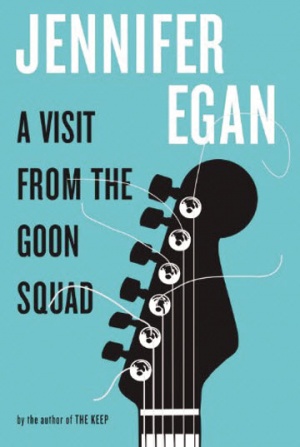 Each day leading up to the March 10 announcement of the 2010 NBCC award winners, Critical Mass highlights one of the thirty-one finalists (to read other entries in the series, click here). Today, NBCC board member Colette Bancroft discusses fiction finalist Jennifer Egan's A Visit From the Goon Squad (Knopf).
Each day leading up to the March 10 announcement of the 2010 NBCC award winners, Critical Mass highlights one of the thirty-one finalists (to read other entries in the series, click here). Today, NBCC board member Colette Bancroft discusses fiction finalist Jennifer Egan's A Visit From the Goon Squad (Knopf).
Jennifer Egan’s A Visit From the Goon Squad mashes up experimental technique with rock-solid realism to create a book that is at once a joyful blast of youth and an unsettling evocation of that universal phenomenon of middle age: Wait a minute, how the hell did we get old?
The structure of Goon Squad blurs the line between novel and linked short stories, with a large cast of characters who scatter and rebound and intertwine in unexpected ways over 50 years. Most of the chapters are connected in some way to two recurring characters, Sasha Grady and Bennie Salazar. We first meet Sasha in her 30s, not long after the turn of the 21st century. In a chapter called “Found Objects,” she relates to her therapist her compulsion to steal random stuff: an untended wallet, a plumber’s screwdriver, a child’s dropped scarf. She won’t prove an easy character to like––she is, after all, the sort of person who orders a Melon Madness Martini––but watching the changes she goes through is fascinating.
In “The Gold Cure,” one of Sasha’s phases finds her working as an assistant to Bennie, a job that began at the height of his career as a record producer in the 1990s. We meet him on the painful slide down from that height, as technology alters an art and business he has loved since he was a boy: “The problem was precision, perfection; the problem was digitalization, which sucked the life out of everything that got smeared through its microscopic mesh. Film, photography, music: dead. An aesthetic holocaust. Bennie knew better than to say this stuff aloud.”
Bennie’s attitudes will change; he is nothing if not adaptable. But Egan also shows us where his joy in music began, during in his teens in San Francisco, where he’s part of a tight-knit group of friends on the fringes of the punk-rock scene in the early ‘80s. In “Ask Me If I Care,” she nails the ecstasy of creating music and captures the pangs of first love in the words of Bennie’s friend Rhea: “Jocelyn knows I’m waiting for Bennie. But Bennie is waiting for Alice, who’s waiting for Scotty, who’s waiting for Jocelyn, who’s known Scotty the longest and makes him feel safe. . . . Jocelyn loves Scotty back, but she isn’t in love with him. Jocelyn is waiting for Lou, an adult man who picked her up hitchhiking. . . . No one is waiting for me. In this story, I’m the girl no one is waiting for.”
Chapters take us backward into Sasha’s childhood and youth as well, and forward through her and Bennie’s relationships, marriages, and parenthood. Goon Squadalso bounces minor characters off into surprising paths. That “adult man” named Lou whom Jocelyn was waiting for is a conspicuously rich, enormously egotistical record mogul who gives Bennie his start but also leaves a widening wake of teenage lovers, bitter ex-wives, and angry, abandoned children. Two of those children try to win Lou’s love in “Safari,” while two of those once-teenage lovers offer him a moment of dying grace in “You (Plural).”
While Bennie is trying to fit into a posh suburb in “A to B,” his brother-in-law, Jules, gets out of prison after assaulting a young movie star he was supposed to be interviewing, which leads us to Jules’ account of that event, “Forty-Minute Lunch: Kitty Jackson Opens Up About Love, Fame, and Nixon!”––a brilliant satire of celebrity journalism––as well as to “Selling the General,” the chilling account of Kitty’s twisted redemption.
Egan doesn’t settle for bringing Sasha, Bennie, and cohorts into the present; she imagines them another 15 or 20 years into the future, where young people avoid tattoos and piercings like the plague. “And who could blame them, Alex thought, after watching three generations of flaccid tattoos droop like moth-eaten upholstery over poorly stuffed biceps and saggy asses?” It’s an all-too-believable future of outdoor concerts swarmed by terrorist-patrol helicopters and electronic communication so ubiquitous people feel uncomfortable talking face to face and prefer to “T” while they’re sitting right next to each other. An entire chapter, “Great Rock and Roll Pauses,” is a PowerPoint presentation on family dynamics assembled by Sasha’s 12-year-old daughter; it may seem like a gimmick but proves to be quietly poignant.
A Visit From the Goon Squad wraps big themes––art and its relationship with technology, the fluid nature of the self, love and its loss––in stories with a satiric edge, believable but never predictable characters, and a range of styles masterfully rendered. Hilarious, moving, and wise, it’s a fine dance to the music of time.
To access Jennifer Egan's website, which contains links to numerous reviews of A Visit From the Goon Squad, click here. Click on the links in the text to read the excerpted chapters.


